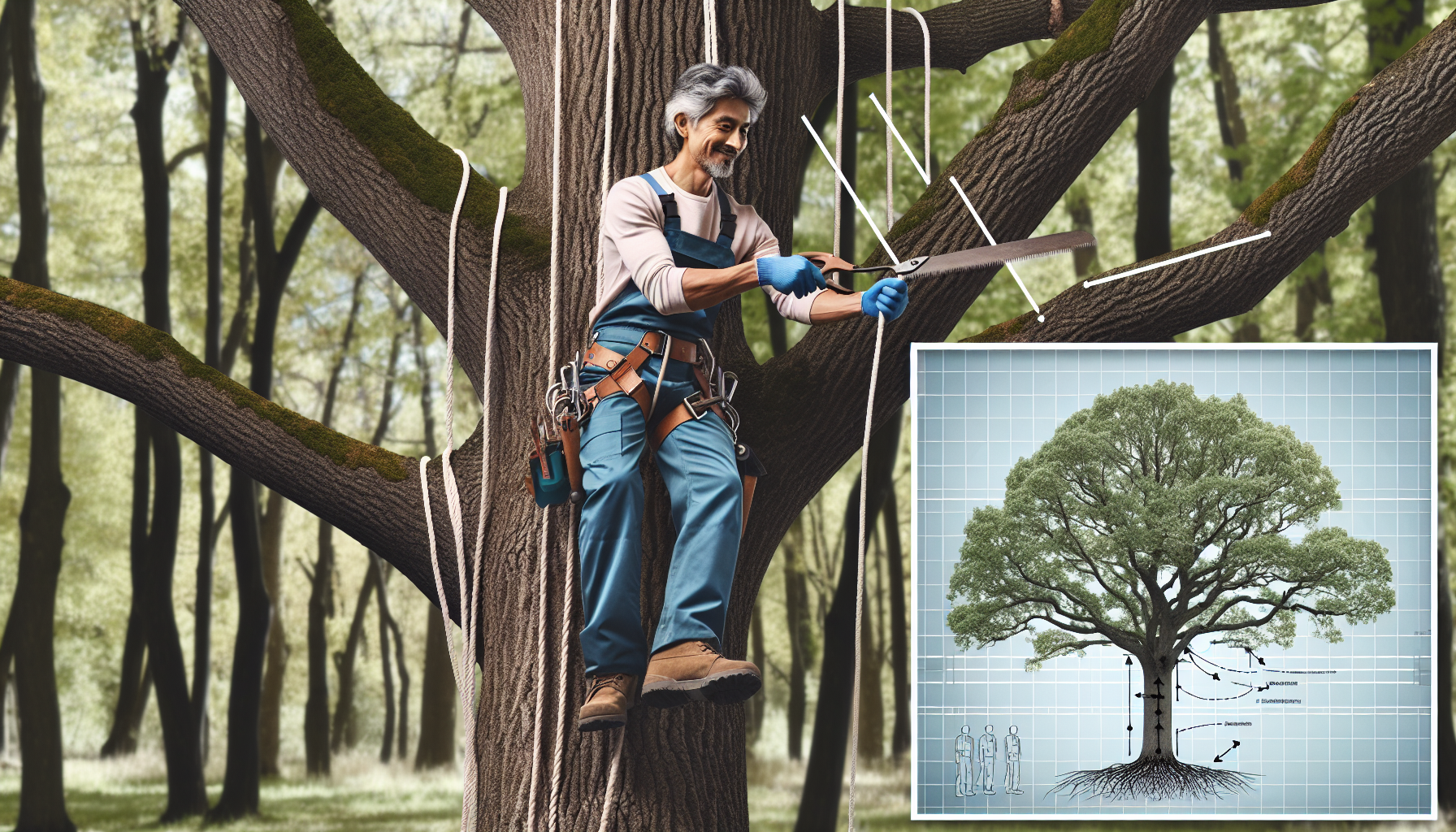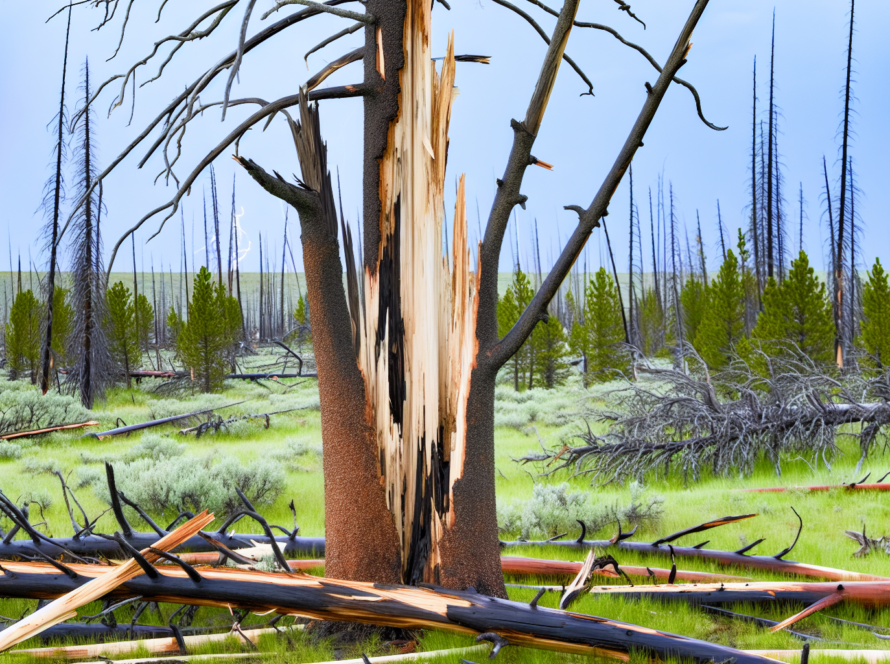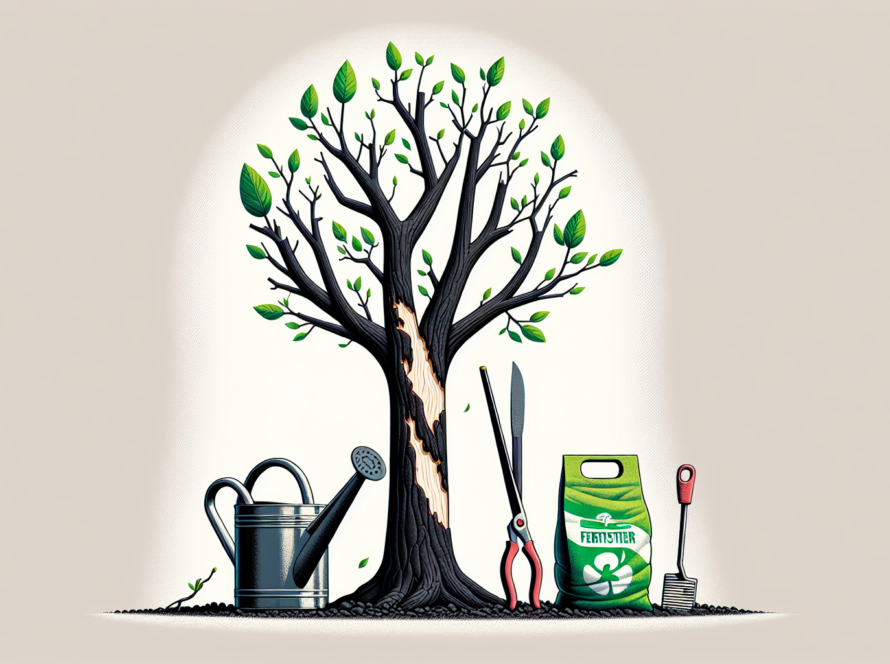If you’re asking when is the best time to trim an oak tree, you’ll find that the sweet spot is between the late fall and winter months. This period is optimal as oaks are dormant and less vulnerable to diseases. Yet, not when it’s too cold, to prevent damage. Ready to learn about the dos and don’ts and strategic timing for healthy oaks? We’ll delve into that next, helping you ensure your tree thrives after a trim.
Key Takeaways
The optimal time for trimming most oak trees is during their dormant phase, between late fall and winter, specifically from November through April, to reduce stress on the trees, improve healing, and prevent the spread of diseases like oak wilt.
Different oak species have their unique needs and growth patterns that affect trimming requirements; therefore, species-specific considerations and proper identification are essential, and consulting an arborist may be necessary for tailored trimming.
Proper trimming involves using the right tools and techniques, such as the two-cut method for mature trees, and taking care to not over-prune or make improper cuts to maintain the tree’s structure, health, and prevent disease.
Determining the Optimal Time for Oak Tree Trimming

There’s a time for everything, and for oak trees, the best time to trim is during the late fall and winter months, generally between November and April. What makes this timing critical? During these months, oak trees enter their dormant phase. Like a hibernating bear, oaks take a break from growing, allowing them to recover more swiftly from the wounds caused by pruning. Nevertheless, it’s imperative to refrain from trimming in extremely cold temperatures, which can lead to freeze-induced dieback and drain the tree’s energy reserves.
Thus, the ideal time for trimming not only ensures effective healing but also prevents the spread of diseases like oak wilt.
Dormancy: Nature’s Healing Phase
Think of an oak tree’s dormant phase as a time for rejuvenation. This rest state, which typically occurs during late fall and winter, provides an optimal time for trimming. Trimming during this period offers several benefits:
Minimizes stress on the tree
Paves the way for a more robust resurgence of the tree in spring
Offers better visibility for precise pruning, as there is no foliage to obstruct the view
Makes it easier to identify and remove diseased or problematic branches
Keep in mind, timing is just one facet. We should also examine the potential risks and outcomes of trimming in other seasons.
Risks of Spring and Summer Pruning
While early spring and summer may seem like pleasant times for a gardening activity like pruning, they’re actually risky seasons for oak trees. Trimming oaks from April to July significantly increases their risk of contracting oak wilt, a disease detrimental to the trees’ health.
This disease is caused by the fungus Bretziella fagacearum, which spreads through beetles. These beetles are attracted to fresh wounds on oaks caused by pruning and are more active in warmer temperatures. To protect your oak trees against such threats, it’s recommended to refrain from pruning during the high-risk period from April to August.
Recognizing Different Oak Species and Their Trimming Needs

Just as we tailor our care for different types of pets, different oak species may have unique trimming needs that must be taken into account. While the ideal time for trimming most oak trees is during the fall and winter, species-specific issues can influence when the best time to trim a particular oak species is. Given the complexity of these needs, consulting an expert might be necessary to address the specific trimming requirements of different oak species.
Red Oaks vs. White Oaks
Take red oaks and white oaks, for example. These species have distinct characteristics that affect their pruning needs.
White oaks have ashy-colored bark with deep ridges and leaves with rounded tips.
Red oaks exhibit smoother bark with very few deep ridges and leaves with pointy ends.
Red oaks are highly susceptible to oak wilt and can die within four to six weeks of infection.
In contrast, white and bur oaks are more tolerant to the disease and do not form fungal mats.
Furthermore, their growth patterns and size also influence their trimming requirements. White oaks can reach around 80 feet in height with widths almost equal to their height. Red oaks typically grow to approximately 75 feet tall with a leaner form and less lateral branch spread.
Unique Growth Patterns and Pruning Techniques
These varying growth patterns influence the pruning techniques employed. For instance, white oaks tend to grow more slowly and live longer than red oaks. This slow growth means that white oaks require less frequent pruning compared to other species. Hence, optimal pruning techniques differ among oak species due to their distinct growth patterns.
Understanding these unique traits will allow you to tailor your trimming techniques to each oak species’ specific needs.
Essential Tools and Equipment for Oak Tree Trimming

Understanding when and how to trim is vital, as is possessing the appropriate tools for the task. Pruning shears, lopping shears, and durable saws are essential for trimming oak trees. These tools allow for precise cuts that prevent poor healing and minimize damage to the tree. In the case of larger limbs and complex jobs, chainsaws are instrumental, while grapple trucks assist in removing heavy debris during tree removal or cleanup activities.
What about those towering branches that appear unreachable? Well, specialized climbing gear such as harnesses and ropes or pole saws and pruners with extendable poles can be utilized to eliminate the need for climbing. And let’s not forget about safety. Arborists must equip themselves with helmets, eye and ear protection, gloves, and chaps to safeguard against hazards.
Choosing the Right Pruning Shears and Saws
Selecting the suitable tool for the task holds utmost significance. For trimming trees, especially larger branches on oak trees, saws are necessary. On the other hand, lopping shears are best suited for trimming branches that are slightly out of reach.
The right tools not only make the job easier but also ensure that your oak trees are trimmed in a way that promotes their health and growth.
Proper Tool Maintenance and Sanitization
However, possessing the right tools isn’t sufficient. Keeping these tools clean and sanitized is equally important. Before oak tree trimming, it is essential to clean and sanitize trimming tools. This helps minimize the risk of spreading diseases between oak trees. You can sanitize pruning tools with rubbing alcohol before and during the pruning process to prevent the spread of disease from one tree to another.
For a more thorough cleaning, tools should be soaked in a solution made up of nine parts water to one part bleach before use. You can also use a scrub brush alongside the disinfectant for a more thorough cleaning of the tools’ blades. Don’t forget to safeguard yourself with plastic gloves and safety glasses to avoid chemical burns or eye injuries.
After sanitizing, tools should be rinsed with water to remove the disinfectant, allowed to air dry, and then oiled to maintain their quality and prevent corrosion.
Mastering Oak Tree Trimming Techniques

Trimming an oak tree involves more than just making a few random cuts. It involves understanding specific oak species, the tree’s age and health, correct tool preparation, proper equipment selection, timing, and employing appropriate techniques for healthy growth. Pruning should be light for all oaks, focusing on dead or diseased branches to cater to their different needs, whether they are deciduous or evergreen.
After trimming, apply a thin coat of pruning seal on oak wounds immediately to prevent fungal spore infections, covering not only pruning cuts but also wounds from other damage. Pruning is done with the overall goal of improving the oak tree’s health. This is achieved by removing only detrimental parts like dead or diseased branches.
Correct Pruning Cuts and Angles
Executing the right pruning cuts and angles is fundamental for the tree’s healing and recuperation process. For this reason, the two-cut method is recommended instead of a single cut to prevent bark damage when removing large branches from mature oak trees. This method involves:
A shallow undercut a couple of inches from the branch collar
A top cut a few inches out to remove the majority of the limb, leaving a small stub
The small stub is then cleanly cut past the branch collar
To ensure the mature oak tree heals properly after pruning, the following steps should be followed:
Preserve the swollen ring at the base of the branch known as the branch collar.
Avoid flush and stub cuts.
Make correct pruning cuts just outside the branch collar.
Cut at proper angles to avoid harming the main trunk.
Ensure the tree forms a natural seal over the wound.
Promote healthy recovery.
By following these steps, you can ensure that the oak tree heals properly after pruning.
Thinning, Shaping, and Crown Raising
Different trimming techniques can be employed to improve the oak tree’s health and appearance. Some of these techniques include:
Thinning: This lessens the canopy density, improving light penetration and air circulation.
Shaping: This maintains the tree’s natural form.
Crown raising: This creates clearance beneath the tree.
When thinning an oak tree, it is important to retain the tree’s dominant leader for structural integrity and not remove more than one-third of the canopy to avoid stress on the tree. Focus on removing dead, diseased, or rubbing branches.
Crown raising should be executed gradually over time if significant clearance is needed, ensuring tree health by removing lower branches carefully to prevent damage to the main trunk, while keeping the tree’s shape balanced. Avoid lion tailing or poodle tailing, which involve stripping the interior branches of an oak tree and can lead to excessive end weight and limb breakage.
Caring for Mature Oak Trees: Special Considerations

Mature oak trees can be likened to seasoned veterans. They’ve weathered countless seasons and have their own unique needs. Excessive trimming can lead to stress in mature oak trees, necessitating careful consideration during pruning to maintain tree health and stability.
As a rule of thumb, a mature oak tree should not have more than 15% of its branches trimmed at once, and not more than 25% of the branches should be removed in a single season. Proper trimming of mature oak trees supports better nutrition distribution and encourages growth, allowing the tree to devote more energy to sustaining and developing its branches.
Reasons for Trimming Mature Oaks
Trimming mature oaks can provide several benefits, including:
Preventing damage and disease by pruning larger, older limbs that grow inward towards the trunk
Maintaining the structural integrity of the tree through extensive developmental trimming
Stimulating growth and shaping the tree
Removing dead or diseased branches to promote overall tree health
Practicing healthy pruning, including making a proper pruning cut, on mature oak trees and younger trees is important to ensure their longevity and vitality.
Properly trimming mature oaks can stimulate new growth, especially when done in winter during the tree’s dormancy. Crown raising enhances a tree’s vigor by redirecting energy resources to other parts of the tree, which is beneficial for mature oaks. Trimming the lower branches of mature oaks improves sunlight penetration and airflow to the grass or plants below.
The Two-Cut Method
The two-cut method is recommended for trimming larger branches on mature oak trees to avoid damage. This method minimizes bark tearing and potential long-term damage when cutting large branches.
When using the two-cut method for branches over 1.5 inches in diameter, follow these steps:
Start with an initial cut 6 to 12 inches from the trunk.
Make a second cut 1 to 2 inches beyond the initial cut.
Finalize with a cut just beyond the branch collar and bark ridge.
This method ensures that the tree can heal properly, maintaining its health and beauty.
Avoiding Common Oak Tree Trimming Mistakes
Much like there are recommended practices in oak tree trimming, there are also frequent errors that should be circumvented. These include:
Heading cuts
Lion tailing
Flush cuts
Stub cuts
Topping and heading back limbs on oak trees can lead to the death of slow-growing trees or cause weak and unsightly limb regrowth. Making heading cuts without considering the natural growth shape and direction of the oak tree can disrupt its growth pattern. Over-pruning can expose oak trees to undue stress and potentially lead to disease infection, which should be avoided.
You can identify over-pruning by the presence of water sprouts, dead branches, or an overabundance of quick growth, indicating the tree’s health may be compromised.
Steering Clear of Improper Cuts
Improper cuts can cause significant damage to the tree’s structural integrity and health. Some examples of improper cuts include:
Heading cuts
Lion tailing
Flush cuts
Stub cuts
These types of cuts can cause significant damage to the structural integrity and health of an oak tree. For example, flush cuts remove the branch collar, which cannot be corrected and may never heal, leading to rot and potential tree failure. Stub cuts are unsightly and can also lead to decay when not addressed. It is important to avoid these types of cuts to ensure the health and longevity of your trees.
That’s the reason it’s paramount to employ the three-cut pruning technique, as it helps form a callus where the removed branch once was, which is vital for the tree’s recovery and future growth.
Over-Pruning and Its Consequences
Over-pruning an oak tree can lead to stress, making the tree more susceptible to diseases and compromising its overall health. Signs such as water sprouts or an overabundance of quick growth can indicate that an oak tree’s health is being jeopardized by over-pruning. Over-thinning or lion-tailing can create hazardous situations with continuous limb breakage and hanging, leading to additional costs for removal and replacement when the compromised trees die.
A well-balanced approach to oak tree trimming is crucial, ensuring that no more than 15% of the branches are removed at a time to maintain structural soundness and photosynthetic capacity.
Oak Tree Disease Prevention Through Proper Trimming
Trimming your oak tree isn’t solely about enhancing its appearance or managing its size. It also concerns disease prevention. Pruning during the oak tree’s dormant period can control the spread of diseases, as the trees are less attractive to disease-carrying insects. Oak trees are most susceptible to diseases like oak wilt during the active growth period in spring and early summer.
To prevent diseases such as oak wilt, it’s advisable to trim oak trees during winter months, apply pruning sealants if necessary, and ensure diseased branches are disposed of correctly. Hence, reducing the risk of disease transmission through pruning is most effective during the colder, dormant months.
But prevention doesn’t end with trimming. It also involves performing routine visual inspections of oaks to detect early signs of disease or insect damage, enabling prompt preventive action. And of course, correctly identifying the oak tree species before pruning is crucial to minimize the risk of adversely affecting the tree’s health.
Timing and Disease Prevention
Timing plays a critical role in disease prevention. Trimming oak trees during the late fall and winter months from January to March, when trees are dormant, significantly reduces the risk of spreading diseases like oak wilt because pathogens are less active. In the spring and summer, fungal mats can develop on infected trees, releasing spores that attract beetles, which in turn can spread oak diseases to freshly pruned trees.
If oak trees must be pruned during spring or summer to address storm damage or other critical issues, it is advised to paint pruning cuts with latex house paint immediately (within 15 minutes) to prevent oak wilt transmission.
Disposing of Diseased Branches Properly
Proper disposal of infected branches is vital in preventing the transmission of oak tree pathogens. Movement of host plants and parts out of quarantined areas is strictly regulated by the California Department of Food and Agriculture and the U.S. Department of Agriculture Animal and Plant Health Inspection Service to prevent the spread of oak disease pathogens like Phytophthora ramorum.
In non-infested areas, plant debris should be removed from the property to prevent introducing diseases, while in infested areas, it’s recommended to leave debris on site or utilize chipping and repurposing as part of a containment strategy. Ensuring that infested plant materials, such as diseased branches, are disposed of correctly is crucial to avoid transferring oak tree pathogens to uninfested areas.
Sanitation measures, including the cleaning and disinfecting of pruning tools after use on infected oak trees, are important preventive steps against the spread of diseases.
Post-Trimming Oak Tree Maintenance
Once you’ve trimmed your oak tree, the task isn’t completed. Regular inspections and the expertise of an ISA-certified arborist become crucial for spotting early signs of distress or disease and curating tailored care. Following trimming, maintaining proper watering and protecting the oak trees from weeds and environmental stress helps ensure their recovery and continued growth.
Balanced nutrition is vital for an oak tree following trimming, as it’s the foundation for strong growth and recovery, similar to a sprinter needing the right nutrition to finish a race. While the application of pruning sealants can be part of post-trim care, it is often not necessary for mature oak trees due to their natural healing processes.
Engaging an ISA-Certified Arborist
For the sustained health and vitality of your oak trees, it’s suggested to enlist the services of an ISA-certified arborist. An ISA-certified arborist possesses a deep understanding of arboriculture, acquired through passing a comprehensive examination and having at least three years of practical experience. They are bound by a code of ethics that ensures they provide services with integrity, honesty, and due care, committing to ongoing education to stay informed on the latest techniques and research.
Engaging an ISA-certified arborist guarantees expert advice and tree care that is rooted in a comprehensive knowledge base, ensuring that the unique needs of each oak tree are met with precision.
Establishing a Routine Maintenance Plan
Much like a workout routine enhances our health, a regular maintenance plan aids in preserving the overall health of the tree and averts potential problems. A routine maintenance plan should involve professional services such as:
Pruning
Removal
Inspections
Treatments for diseases
Ensuring overall tree health is essential, especially when it comes to majestic trees and maintaining their tree branches. A professional tree service can help in achieving this goal.
Oak trees require minimal watering, adhering to a monthly schedule, and avoiding close proximity to water-loving plants to prevent overwatering and maintain their health. Young and mature oak trees benefit from targeted fertilization, best applied in spring, late summer, and autumn to coincide with rainfall that aids in nutrient distribution.
Summary
To sum up, trimming oak trees is an art and science that requires understanding the tree’s unique needs, using proper tools, employing correct techniques, and regular post-trim maintenance. The key takeaway is that with proper care, including appropriate timing, methodical techniques, and diligent post-trim maintenance, oak trees can thrive, enhancing our landscapes with their majestic presence.
Frequently Asked Questions
Should I cut the lower branches of an oak tree?
Yes, you can prune the lower branches of an oak tree to make mowing easier and allow sunlight to reach the ground, but avoid using pruning sealer or similar products.
How do you trim an oak tree without killing it?
To trim an oak tree without killing it, only remove up to 25% of the branches in one season. Cut without leaving a nub, and avoid cutting into the branch collar. Mastering this technique will help the tree to heal properly.
What time of year should you prune oak trees?
To ensure the health of your oak trees, prune them when they are dormant in late winter or very early spring, before March 15th, to avoid the activity of insects that spread oak wilt.
Is it OK to trim trees in the summer?
Yes, it is okay to trim trees in the summer, especially for structural cleanup and removing dead, diseased, and damaged wood.
Why is it important to sanitize pruning tools?
Sanitizing pruning tools is important as it helps minimize the risk of spreading diseases between plants. Be sure to clean your tools regularly to protect the health of your plants.




